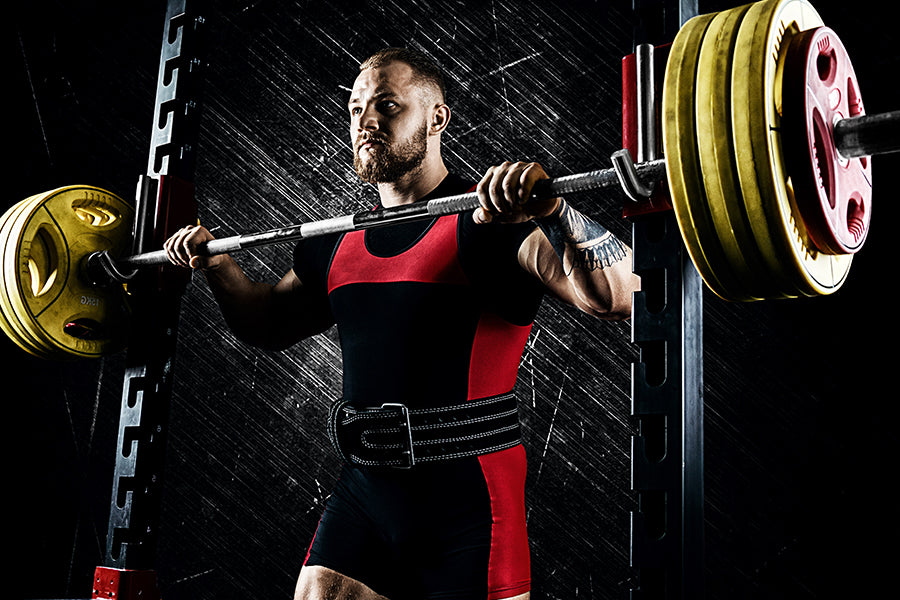Weightlifting belts have been a topic of debate for years. Some people swear by them, while others believe they are a waste of time. So, should you wear one while training?
A weightlifting belt is an essential piece of equipment for your fitness journey. It can help you improve your performance in the gym by supporting your spine and protecting your back from injury.
Here is a closer look at the weightlifting belts to help you make an informed decision.
What is a Weightlifting Belt?
A weightlifting belt is a tool used by weightlifters and bodybuilders to provide extra support during heavy lifting exercises. The primary purpose of a weightlifting belt is to protect the user's back by spreading out the weight of the barbell across their torso to reduce pressure on the spine and allow lifters to lift heavier weights without compromising their form.
It can also prevent lumbar hyperextension, a spinal injury that occurs when you arch your back during the lifting process. It can cause severe back pain and even paralysis if left untreated.
Overall, weightlifting belts can help prevent many injuries and keep users healthy. But before we get into the benefits of using a weightlifting belt, let's look at the available types of weightlifting belts and decide which one is right for you.
Related Article: Weight Lifting Belt - The Absolute Protection You Need When Lifting Heavy Weights
Types of Weightlifting Belts
There are various weightlifting belts on the market, including padded and unpadded styles and nylon and leather models. Some of the most common weightlifting belts include powerlifting belts, dipping belts, bodybuilding belts, and nylon belts. What is the purpose of these belts, and which one is best for your workout?
Lever Belt
The Lever Belt is used by lifters using the lever system popularized by Louie Simmons in his "Power Factor" training method. The lever belt attaches around the waist to support the lower back and help stabilize the core and abdominal muscles.
Since it's designed to support specific body positions and movements during lifts, the lever belt is often considered the best type of weightlifting belt for intermediate and advanced.
These are very common belts used by powerlifters leading up and during their competition. These felts are extremely robust and provide a high degree of customization.
Neoprene Weightlifting Belt
This belt is easier to transport and put on, yet it is still robust enough to see you through the early phases of your weightlifting journey. In addition, neoprene belts offer greater mobility, which makes them preferred for strenuous exercises such as deadlifts, swings, and other similar activities.
Neoprene belt is recommended for beginner and intermediate weightlifters who want to protect their lower backs during heavy sets and maximize their power. It's also worth noting that many bodybuilders train without belts to optimize their range of motion and boost their flexibility.
This belt style can also be used for other sports such as Crossfit, gymnastics, or bodybuilding to help increase stability and support throughout your workout.
Dip Belt
A dip belt functions much like a standard weightlifting belt, encircling the lower abdomen. The distinguishing feature is a means (a chain or strap) to fasten a weight of your choosing to the front of the belt.
The dip belt is a specialty style used by more advanced athletes in weightlifting to power through dips and pull-ups.
The thick rubber padding prevents slippage off your hips and helps keep it snug around your waist.
Leather Weightlifting Belt
The leather weightlifting belt is composed of sturdy, long-lasting leather, making it ideal for heavy lifting. Even if you exercise for longer, it will not slide off your body and will remain in place.
The belt's straps are adjustable so that you can fasten them in place according to your needs.
Because this type of belt is padded from the inside, it will prevent any rashes from appearing elsewhere on your body. It has sufficient width, and the fact that it is made of a robust substance ensures a longer usage life.
The Benefits of Weightlifting Belts
While there are multiple benefits associated with weightlifting belts, the primary is that they can help you perform more reps and sets with less fatigue; before using a belt for the first time, get the proper fit to prevent injury and avoid unnecessary pressure on your muscles.
Let's discuss some of the benefits of weightlifting belts in detail below.
Prevents Lower Back Injuries
The primary benefit of using a weightlifting belt is that it helps you lift more weight without straining your back. This is especially important for people with weak backs who need to improve their strength without risking injury.
In addition, an adjustable weightlifting belt allows the instructor to adjust the level of support you need for a particular exercise based on your current fitness level and goals.
Improves Posture
An adequately fitted weightlifting belt provides compression and support to your lower back to reduce stress on the muscles and tendons in the area and improve your posture during exercise. This allows you to engage in more intense training with fewer risks of injury.
Gives You More Power
A weightlifting belt could be the answer if you want to build muscle and strength but are still waiting for the results. It can give you the extra boost you need to push your body to the next level and help increase your performance in the gym.
Since it's designed to wrap around your waist and offer extra support, it can help prevent twisting or pulling when performing specific exercises. In addition, it will help stabilize your spine and keep proper form during workouts.
Reduces Fatigue
Using a weightlifting belt can be especially helpful if you tend to be over-ambitious in your workout routine. It helps you stay focused and perform better for longer by distributing the weight evenly across the abdominal area and minimizing discomfort and fatigue.
Protects Your Spine
When you lift weights without a weightlifting belt, all the pressure is concentrated on your lower back, which can lead to injuries over time. The support and protection offered by a weightlifting belt can help take pressure off your spine and protect the muscles in the area from strain and stress.
How to Properly Wear a Weightlifting Belt
When lifting with a weight lifting belt, it is essential to ensure it is well-fitted to your body to get the maximum benefit from the belt. There are multiple views for fitting belts, but the most important thing is that the belt fits well. It should be tight enough to constrict. Let's walk down the path of how to fit the belt.
Three common waist/hips measurements must be accurate for the belt to fit correctly. Once you have measured yourself, you should have at least 1-2 inches in girth to tighten the belt to where it needs to be and not restrict movement. This will give you the right amount of tightness with the belt to give you the support you want and need to exercise while exercising in the gym.
Related Article: How to Use Weight-Lifting Belt
How to Find the Right Lifting Belt
Here is a chart to help you find the right lifting belt for your needs and skill level:
|
Types of Belts |
Adds Stability |
Add Weight To |
Beginner |
Advanced |
|
Lever Belt |
|
|
|
|
|
Neoprene Weightlifting Belt |
|
|
||
|
Dip Belt |
|
|
||
|
Leather Weightlifting Belt |
|
FAQs
1. What are the benefits of wearing a weightlifting belt?
A weightlifting belt can help support your abdominal muscles and help keep your back straight when lifting weights. This can help prevent injuries and improve your workout performance.
2. When should I start wearing a weight-lifting belt?
If you've recently started lifting weights or want to increase your overall strength, you can introduce a weightlifting belt during your workout sessions. This will help you protect your back and increase your stability. But you must start slowly to get used to wearing the belt and ensure it doesn't cause discomfort.
3. At what weight should I use a belt for squats?
It depends on your lifting skill and perceived level of exertion for the particular lift. A good rule of thumb is to apply a belt when you feel your form is going to be compromised.
4. At what weight should I use a belt for deadlifts?
It depends on your lifting skill and perceived level of exertion for the particular lift. A good rule of thumb is to apply a belt when you feel your form is going to be compromised.
5. Why do bodybuilders wear belts all the time?
Strength training is the foundation of bodybuilding, and strength is essential for enhancing muscle definition and achieving greater fitness levels. Bodybuilders use belts because they can provide additional support when lifting heavy weights at the gym.
The Bottom Line
The expert argues that it's recommended that you progress from doing only free weight to doing progressive resistance exercises with weights strapped to your body. This way, the muscles will work harder due to the added weight, and the risk of getting injured will decrease. In addition, wearing a weightlifting belt will help keep your back straight and prevent injury.








